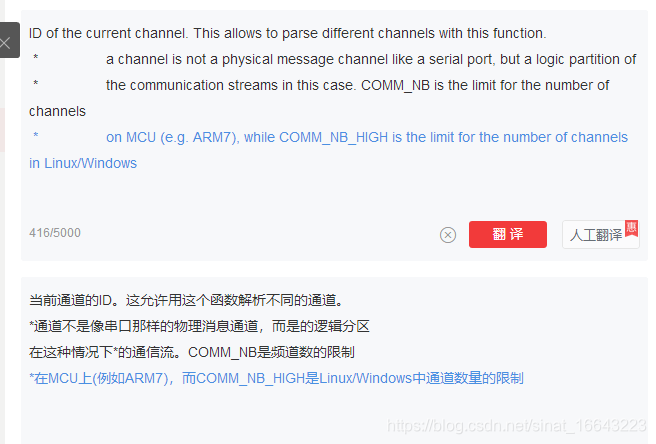我一开始想既然mavlink在STM32的使用只需要调用函数就可以了,但是mavlink在STM32的代码似乎比较多,我就想起直接看它的头文件有哪些函数,结果查看头文件有巨大发现
对应每种消息都有专门一个头文件,我甚至找到了vision_positon_estimate的头文件,是不是要读取某类消息只需要调用这个对应消息头文件里面的函数就可以了。
是不是在驱动文件include这个头文件就可以了,然后直接调用就可以了。好像main文件要Include mavros.h
https://blog.csdn.net/sinat_16643223/article/details/108916785


在这个头文件里面我找到了似乎是对应读取某个参数的,这么来看用mavlink其实挺方便的。
那我再写驱动或者ACfly的传感器二次开发很方便了,都不需要自己写协议解析,就调用一个函数得到数据之后直接传给更新函数就行了。
static inline uint64_t mavlink_msg_vision_position_estimate_get_usec(const mavlink_message_t* msg)
{
return _MAV_RETURN_uint64_t(msg, 0);
}
/**
* @brief Get field x from vision_position_estimate message
*
* @return [m] Global X position
*/
static inline float mavlink_msg_vision_position_estimate_get_x(const mavlink_message_t* msg)
{
return _MAV_RETURN_float(msg, 8);
}
/**
* @brief Get field y from vision_position_estimate message
*
* @return [m] Global Y position
*/
static inline float mavlink_msg_vision_position_estimate_get_y(const mavlink_message_t* msg)
{
return _MAV_RETURN_float(msg, 12);
}
/**
* @brief Get field z from vision_position_estimate message
*
* @return [m] Global Z position
*/
static inline float mavlink_msg_vision_position_estimate_get_z(const mavlink_message_t* msg)
{
return _MAV_RETURN_float(msg, 16);
}
/**
* @brief Get field roll from vision_position_estimate message
*
* @return [rad] Roll angle
*/
static inline float mavlink_msg_vision_position_estimate_get_roll(const mavlink_message_t* msg)
{
return _MAV_RETURN_float(msg, 20);
}
/**
* @brief Get field pitch from vision_position_estimate message
*
* @return [rad] Pitch angle
*/
static inline float mavlink_msg_vision_position_estimate_get_pitch(const mavlink_message_t* msg)
{
return _MAV_RETURN_float(msg, 24);
}
/**
* @brief Get field yaw from vision_position_estimate message
*
* @return [rad] Yaw angle
*/
static inline float mavlink_msg_vision_position_estimate_get_yaw(const mavlink_message_t* msg)
{
return _MAV_RETURN_float(msg, 28);
}
/**
* @brief Get field covariance from vision_position_estimate message
*
* @return Pose covariance matrix upper right triangular (first six entries are the first ROW, next five entries are the second ROW, etc.)
*/
static inline uint16_t mavlink_msg_vision_position_estimate_get_covariance(const mavlink_message_t* msg, float *covariance)
{
return _MAV_RETURN_float_array(msg, covariance, 21, 32);
}
/**
* @brief Decode a vision_position_estimate message into a struct
*
* @param msg The message to decode
* @param vision_position_estimate C-struct to decode the message contents into
*/
static inline void mavlink_msg_vision_position_estimate_decode(const mavlink_message_t* msg, mavlink_vision_position_estimate_t* vision_position_estimate)
{
#if MAVLINK_NEED_BYTE_SWAP || !MAVLINK_ALIGNED_FIELDS
vision_position_estimate->usec = mavlink_msg_vision_position_estimate_get_usec(msg);
vision_position_estimate->x = mavlink_msg_vision_position_estimate_get_x(msg);
vision_position_estimate->y = mavlink_msg_vision_position_estimate_get_y(msg);
vision_position_estimate->z = mavlink_msg_vision_position_estimate_get_z(msg);
vision_position_estimate->roll = mavlink_msg_vision_position_estimate_get_roll(msg);
vision_position_estimate->pitch = mavlink_msg_vision_position_estimate_get_pitch(msg);
vision_position_estimate->yaw = mavlink_msg_vision_position_estimate_get_yaw(msg);
mavlink_msg_vision_position_estimate_get_covariance(msg, vision_position_estimate->covariance);
#else
uint8_t len = msg->len < MAVLINK_MSG_ID_VISION_POSITION_ESTIMATE_LEN? msg->len : MAVLINK_MSG_ID_VISION_POSITION_ESTIMATE_LEN;
memset(vision_position_estimate, 0, MAVLINK_MSG_ID_VISION_POSITION_ESTIMATE_LEN);
memcpy(vision_position_estimate, _MAV_PAYLOAD(msg), len);
#endif
}
还有一个问题,怎么给mavlink指定串口。指定是用哪个串口接收和发送。
下面这里有讲到,这篇文章我也应该转载过。
https://blog.csdn.net/sinat_16643223/article/details/108917748

这篇也讲到了
https://blog.csdn.net/sinat_16643223/article/details/108918061
![]()
https://blog.csdn.net/sinat_16643223/article/details/108919187

https://blog.csdn.net/sinat_16643223/article/details/108919472

这下面的pressure应该泛指某一类消息,比如可以用vision_positon_estimate替代掉pressure
而且下面说了接收消息就是我上面找到的那几个get函数!!!!!!
https://www.jianshu.com/p/e57aa664103f?from=singlemessage

这个mavlink_parse_char函数我也找到了,是就在 mavlink_helpers.h中,直接ctrl + F可以搜到。
那它是在哪里指定用哪个串口的呢。
这个函数前面的注释里面有对各个输入参数解释,似乎第一个参数就和串口有关?
chan应该就是channel的简写,应该就是通道的意思!!!!!!


/**
* This is a convenience function which handles the complete MAVLink parsing.
* the function will parse one byte at a time and return the complete packet once
* it could be successfully decoded. This function will return 0 or 1.
*
* Messages are parsed into an internal buffer (one for each channel). When a complete
* message is received it is copies into *returnMsg and the channel's status is
* copied into *returnStats.
*
* @param chan ID of the current channel. This allows to parse different channels with this function.
* a channel is not a physical message channel like a serial port, but a logic partition of
* the communication streams in this case. COMM_NB is the limit for the number of channels
* on MCU (e.g. ARM7), while COMM_NB_HIGH is the limit for the number of channels in Linux/Windows
* @param c The char to parse
*
* @param returnMsg NULL if no message could be decoded, the message data else
* @param returnStats if a message was decoded, this is filled with the channel's stats
* @return 0 if no message could be decoded or bad CRC, 1 on good message and CRC
*
* A typical use scenario of this function call is:
*
* @code
* #include <mavlink.h>
*
* mavlink_message_t msg;
* int chan = 0;
*
*
* while(serial.bytesAvailable > 0)
* {
* uint8_t byte = serial.getNextByte();
* if (mavlink_parse_char(chan, byte, &msg))
* {
* printf("Received message with ID %d, sequence: %d from component %d of system %d", msg.msgid, msg.seq, msg.compid, msg.sysid);
* }
* }
*
*
* @endcode
*/
MAVLINK_HELPER uint8_t mavlink_parse_char(uint8_t chan, uint8_t c, mavlink_message_t* r_message, mavlink_status_t* r_mavlink_status)
{
uint8_t msg_received = mavlink_frame_char(chan, c, r_message, r_mavlink_status);
if (msg_received == MAVLINK_FRAMING_BAD_CRC ||
msg_received == MAVLINK_FRAMING_BAD_SIGNATURE) {
// we got a bad CRC. Treat as a parse failure
mavlink_message_t* rxmsg = mavlink_get_channel_buffer(chan);
mavlink_status_t* status = mavlink_get_channel_status(chan);
_mav_parse_error(status);
status->msg_received = MAVLINK_FRAMING_INCOMPLETE;
status->parse_state = MAVLINK_PARSE_STATE_IDLE;
if (c == MAVLINK_STX)
{
status->parse_state = MAVLINK_PARSE_STATE_GOT_STX;
rxmsg->len = 0;
mavlink_start_checksum(rxmsg);
}
return 0;
}
return msg_received;
}
目前我的理解是,main函数里面include mavlink.h就可以,然后直接调用相应的接收函数,现在问题是那个端口怎么定义的。
ACfly里面mavlink端口方面的



关于端口ACfly就是在commulink.cpp和commulink.h里面弄的!!!!像这个头文件里明确有写注册端口


它应该mavlink里面有某个函数调用了串口接收或者发送函数,我觉得你去深挖那个mavlink自己的接收函数应该是可以最终找到那个串口的函数的。
https://www.cnblogs.com/daxuezhidao/p/5809709.html
这是那个恒力久行自己写的一个头文件,他的教程里是要把他写的这个头文件加进去。

是的,一层层从
mavlink_parse_char函数开始深挖下去,可以找到一些线索。





ACfly里面mavlink通信似乎也是一个单独的任务,就在这个文件里面,我似乎要加mavlink通信只需要在这加就可以了,不需要去main函数加,不需要去主文件那include mavlink.h 而是在这个文件里面调用API函数。端口什么的他应该定义好了我可以在这里面直接用,不需要折腾了。
是不是也就意味着其他任务是没法直接获得mavlink消息的,通过任务间通信来弄,你也不需要在驱动里面去写mavlink,
目前可以知道,每一个传感器都会创建一个线程,我看了下单单uart驱动是没有创建单独线程的,uart驱动应该是在传感器线程里面被调用的。
我觉得mavlink就可以理解为一个传感器驱动,这个驱动它底层应该是调用串口驱动,mavlink本身应该只需要做些协议解析即可,应该不复杂,为什么看到写这么多呢。应该几个函数就可以搞定。

本身这个commulink.cpp(或者说这个任务)里面也有任务间通信的函数

我在mavlink_helpers.h搜索uart有了新发下,就下面标为蓝色的这段代码,

if (chan == MAVLINK_COMM_0)
{
uart0_transmit(ch);
}
if (chan == MAVLINK_COMM_1)
{
uart1_transmit(ch);
}
看到了吧,如果chan == MAVLINK_COMM_0 就调用 uart0_transmit(ch);这里真正把chan和具体的串口驱动函数关联了起来!!!!!也是我之前想的它肯定会调用串口驱动函数的。可是我刚刚发现 uart0_transmit()这个函数在其他地方搜不到,也就是可能串口驱动里面没这个函数。。
然后其他函数再调用这个函数 _mavlink_send_uart(mavlink_channel_t chan, const char *buf, uint16_t len) 这个函数就是调用comm_send_ch(mavlink_channel_t chan, uint8_t ch) 实现的!!!!其他函数又大量调用_mavlink_send_uart(mavlink_channel_t chan, const char *buf, uint16_t len) 这个函数,这个可以通过搜索发现!!!!
我估计接收应该也有一个相应的函数

我这还发现一个mavlink_get_info.h的头文件。

端口似乎就是个数字
我在网上下的别人写好的mavlink收发代码,chan那块也是写个数字0,就我下面标位蓝色的地方,那是个发送函数的第一个参数。
代码是在这里下载的
https://download.csdn.net/download/xiaoxilang/10396810
 这个可不可以去试试深挖一下那个 serial_open(0,0) 看看能不能找出一些串口的线索。
这个可不可以去试试深挖一下那个 serial_open(0,0) 看看能不能找出一些串口的线索。
好像还看到需要自己转成c文件?然后好像没有头文件查看函数定义的时候不好跳转?


这里也说了要生成C代码
https://blog.csdn.net/ybhuangfugui/article/details/82348876

https://zhuanlan.zhihu.com/p/57695663

来源:oschina
链接:https://my.oschina.net/u/4339497/blog/4660575